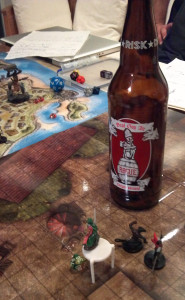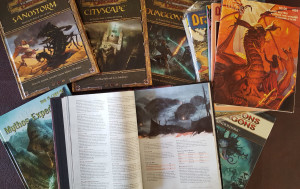A little more than a month ago, I posted my top three tips and tricks on GM’ing. Shortly thereafter a reader took exception with one of my tips, pointing out that the players, not the GM, own the story. Of course, the reader is correct. The players control how the plot unfolds. Their PCs are in charge. What I meant was that the GM is the master of the backstory, the history, the scheming (re)actions of the bad-guys (or good-guys if you are playing an evil campaign). Clearly I am not a professional writer; my use of literary terms can be imprecise. Also, for the most part, I play D&D and its derivatives. I am learning, however. It is with keeping this clarification in mind, that I add three more tips to my previous ones.

Be agile. As GM, you control the reactions of the environment to the PCs interactions. Mastering the environment, the history, the plots, and the NPCs enables you to credibly and quickly provide feedback to the players actions. Hesitation can break an engrossing engagement, as much as a rules discussion. Of course, depending on the type of RPG, a GM may have more or less wiggle-room. In sandbox adventures, there is no prescribed path, perhaps not even an antagonist. Yet, you must let the players shape their world. You have to bend any plot around them. Admittedly, agility can be very difficult, especially with creative players. And, no matter how much you try, you will never predict their every move. So, don’t try. If you know the world, go along for the ride.
Give ownership. From the prologue to the epilogue, ensure your players have a real stake in the world. Let them build their own history and provide familial NPCs. Allow them ties to the community, family lands or businesses, whenever possible. My pirates owned a ship; most of my Varisians own businesses in Sandpoint. None of this is to say that you have to roll play every detail of that ownership. Rather allow players to decide how much personal investment to provide. Crews can swab the decks; employees can run the businesses. In fact, you can use community engagement as a leverage over player tendency towards unrealistic charisma or social skill neglect. Furthermore, you can be inventive in incorporating these investments into the plot. Not only can they can be devices for both employing levity or applying pressure, but also they can provide a crucial personalization of the story.

Make the environment sing. Really sing. Detail the setting. Use pictures that help them visualize or sounds that set the tension. It can be easy to forget the effects of altitude, the difficulty swimming in armor, or the distraction of a crowd. Yet, it is those sensations that both raise the difficulty of a seemingly simple encounter and make one much more memorable. One of the aspects of 4th edition D&D I liked the most was the skill challenge system. It remains one of the most effective systems I’ve seen for seamlessly incorporating environments into encounters. Regardless of the system you use, however, do not forget how much more difficult and exciting encounters can be if you make use the environment. So, even if you don’t memorize (or even read) every rule, be sure to familiarize yourself with any environmental effects. You’ve kept all those old RPG books and magazines for a reason, right? Well, read ’em again. Then bring your best colorful language to the table.
Last week I built and inserted The Azlanti Turkey into my Runelords campaign. Thanksgiving aside, I added it precisely because it provided my players with an unexpected opportunity to add memorably to the PCs involvement in the campaign. I had no idea what they would do with the turkey – kill it and eat it, I supposed. Instead, they decided to capture it in hopes of finding a mate and starting a business raising them back home in Sandpoint. For now, however, they’ve got it sequestered in their portable hole, toting it through the Runeforge. Every time they open the extra-dimensional space, its mouth-watering aroma wafts out. I’ve no idea exactly how this will play out, I’ve got to be ready to incorporate it into another encounter, especially when it becomes conscious. The bottom line is the more time you spend enlivening the environment and the more agile your reactions, the more fun you’ll have on the unexpected journey upon which your players will take you.

I actually think it’s an entirely valid approach for the GM to own the story. The PCs are the heroes of the story. But in many of the most classic (and beloved) stories the heroes have little choice. They’re railroaded into their adventures…often over their strenuous objections.
Hi Allen! This is a complex subject, as I’m discovering. Overall, I think it depends on a couple things. First, as you pointed out, the style of the adventure matters to a degree. A sandbox campaign generally allows for a greater degree of plot development generated by the PCs than a linear adventure path. Though, honestly, I’ve had to go way off script in adventure paths sometimes to allow for player creativity (which in turn helps with player satisfaction because it generates ownership). Second, I think sometimes the language I use to describe various aspects of a campaign is not quite in sync with my intentions. Even what I mean by terms like ‘control’ and ‘story’ can easily get misinterpreted. Third, I would argue that it’s alright for a PC to feel forced, but not a player. In the former case, if every PC feels like they are doing something against their instincts at each turn, then I’d crop it up to a misunderstanding between the GM and the players as to the setting of the campaign.